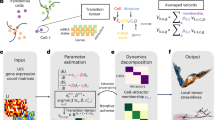Abstract
INDUCTION of mesoderm during early amphibian embryogenesis can be mimicked in vitro by adding growth factors, including heparin-binding and type-beta transforming growth factors (TGF-β), to isolated ectoderm expiants from Xenopus laevis embryos1–5. Although the mesoderm-inducing factor (MIF) from X. laevis XTC cells (XTC-MIF)6,7 has properties similar to TGF-β, this factor is still unidentified. Recently, we obtained a number of homogeneous cell lines from the heterogeneous XTC population, which differ in their MIF production8. Only one, XTC-GTX-11, produced MIF, although it was similar to the rest of the clones in its production of known growth factors, including TGF-β activity8. This observation, together with the identification of activin A as a potent MIF (ref. 9) led us to study the parallel activities of MIF and activin. Here we report an analysis of activin-like activity from XTC cells and some of the XTC clones, including XTC-GTX-11. There is a clear consistent correlation between MIF activity and presence of activin activity, indicating that XTC-MIF is the Xenopus homologue of mammalian activin.
This is a preview of subscription content, access via your institution
Access options
Subscribe to this journal
Receive 51 print issues and online access
$199.00 per year
only $3.90 per issue
Buy this article
- Purchase on Springer Link
- Instant access to full article PDF
Prices may be subject to local taxes which are calculated during checkout
Similar content being viewed by others
References
Slack, J. M. W., Darlington, B. G., Heath, J. K. & Godsave, S. F. Nature 326, 197–200 (1987).
Grunz, H., McKeehan, W. L., Knochel, W., Tiedemann, H. & Tiedemann, H. Cell Diff. 22, 183–190 (1988).
Kimelman, D. & Kirschner, M. Cell 51, 869–877 (1987).
Rosa, F., Roberts, A. B., Danielpour, D., Dart, L. L., Sporn, M. B. & Dawid, I. B. Science 239, 783–785 (1988).
Smith, J. C. Development 105, 665–677 (1989).
Smith, J. C. Development 99, 3–14 (1987).
Smith, J. C., Yaqoob, M. & Symes, K. Development 103, 591–600 (1988).
Snoek, G. T. et al. Expl. Cell Res. (in the press).
Asashima, M. et al. Roux's Arch. dev. Biol. 198, 330–335 (1990).
Murata, M., Eto, Y., Shibai, H., Sakai, M. & Muramatsu, M. Proc. natn. Acad. Sci. U.S.A. 85, 2434–2438 (1988).
Vale, W., Rivier, J., Vaughan, J., McClintock, R., Corrigan, A., Woo, W., Karr, D. & Spiess, J. Nature 321, 776–779 (1986).
Ling, N. et al. Nature 321, 779–782 (1986).
Smith, J. C. Nature 345, 729–731 (1990).
Laemmli, U. Nature 227, 680–685 (1970).
Nieuwkoop, P. D. & Faber, J. Normal Table of Xenopus laevs (Daudin) 2nd edn (North-Holland, Amsterdam, 1967.
Flickinger, R. A. J. exp. Zool. 112, 165–185 (1949).
Author information
Authors and Affiliations
Rights and permissions
About this article
Cite this article
van den Eijnden-Van Raaij, A., van Zoelent, E., van Nimmen, K. et al. Activin-like factor from a Xenopus laevis cell line responsible for mesoderm induction. Nature 345, 732–734 (1990). https://doi.org/10.1038/345732a0
Received:
Accepted:
Issue Date:
DOI: https://doi.org/10.1038/345732a0
This article is cited by
-
Head and trunk-tail organizing effects of the gastrula ectoderm of Cynops pyrrhogaster after treatment with activin A
Roux's Archives of Developmental Biology (1995)
-
Basic fibroblast growth factor can induce exclusively neural tissue in Triturus ectoderm explants
Roux's Archives of Developmental Biology (1994)
-
Identification of TGF-?-related genes in the early chick embryo
Roux's Archives of Developmental Biology (1993)
Comments
By submitting a comment you agree to abide by our Terms and Community Guidelines. If you find something abusive or that does not comply with our terms or guidelines please flag it as inappropriate.



